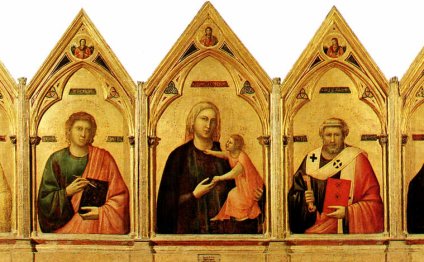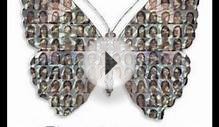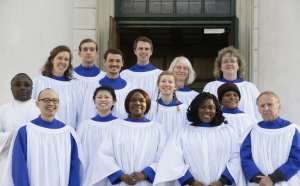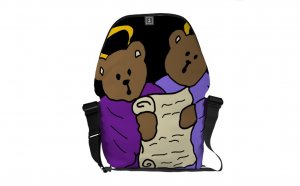
Catholic Choir robes
VestmentsAre liturgical garments and articles associated primarily with the Christian religion, especially among the Eastern Orthodox, Catholics (Latin Church and others), Anglicans, and Lutherans. Many other groups also make use of liturgical garments; this was a point of controversy in the Protestant Reformation and sometimes since, in particular during the Ritualist controversies in England in the 19th century.
Rubrics for vesting[edit]
The rubrics (regulations) for the type of vestments to be worn vary between the various communions and denominations. In some, clergy are directed to wear special clerical clothing in public at all, most, or some times. This generally consists of a clerical collar, clergy shirt, and (on certain occasions) a cassock. In the case of members of religious orders, non-liturgical wear includes a religious habit. This ordinary wear does not constitute liturgical vestment, but simply acts as a means of identifying the wearer as a member of the clergy or a religious order.
A distinction is often made between the type of vestment worn for Holy Eucharist or Holy Communion and that worn for other services. Non-Eucharistic vestments are typically referred to as "choir dress" or "choir habit" in the Roman Catholic, Orthodox, and Anglican churches, because they are worn for the chanting of the Daily Office, which, in the West, takes place in the choir rather than the sanctuary. In other traditions, there is no specific name for this attire, although it often takes the form of a Geneva gown worn with or without preaching bands and a stole or preaching scarf.
In the more ancient traditions, each vestment—or at least the stole—will have a cross on it, which the clergy kiss before putting it on. A number of churches also have special vesting prayers which are recited before putting each vestment on, especially the Eucharistic vestments.
Latin Catholic, Anglican, Lutheran and Protestant vestments[edit]
For the Eucharist, each vestment symbolizes a spiritual dimension of the priesthood, with roots in the very origins of the Church. In some measure these vestments harken to the Roman roots of the Western Church.
Use of the following vestments varies. Some are used by all Western Christians in liturgical traditions. Many are used only in the Roman Catholic and Anglican churches, and there is much variation within each of those churches.
Used by Roman Catholics, Anglicans, Lutherans and some other Protestants[edit]
an item of clerical clothing; a long, close-fitting, ankle-length robe worn by clerics of the Catholic, Eastern Orthodox, Anglican, Lutheran and some Reformed churches. The long, narrow strip of cloth draped around the neck, a vestment of distinction, a symbol of ordination. Deacons wear it draped across the left shoulder diagonally across the body to the right hip while priests and bishops wear it draped around the back of the neck. It may be crossed in the front and secured with the cincture. Traditionally, this was done by priests when wearing Eucharistic vestments, whereas bishops always wore it uncrossed (as possessing the fullness of the priesthood). Modern usage is for both bishops and priests to wear the stole uncrossed. Corresponds to the Orthodox orarion and epitrachelion (see below). The common garment of any ministers at the eucharist, worn over a cassock. Most closely corresponds to the Orthodox sticharion (see below). Symbolizes baptismal garment. See also cassock-alb. or cassalb is a relatively modern garment and is a combination of the traditional cassock and alb. It developed as a convenient undergarment (or alternative to a cassock at the Eucharist) worn by clergy and as an alternative to the alb for deacons and acolytes. A white or off-white cassock-alb has replaced the traditional cassock and alb in some Anglican and Lutheran churches since the 1970s. On rules concerning its use, see The Church Times. A large cross worn on a chain or necklace around the neck by clergy of many Christian denominations. In some traditions it is associated with bishops. In the Roman Catholic tradition it is only worn by bishops, abbots, and certain canons who are granted the use of the pectoral cross by special indult. In choir dress the cross is gold with a green rope, red for cardinals. In house dress, it is silver with a silver chain.Used by Roman Catholics, Anglicans and Lutherans[edit]
A white tunic worn over a cassock or habit. It is commonly worn by altar servers, choir members and also in Catholic and high church Anglicanism it may be worn by clergy who are attending a eucharist but not the celebrant. Among lower church Anglicans and some Lutherans and Methodists the Surplice is sometimes worn with a stole or scarf (and less often by itself) as the proper vestment for the Eucharist. A circular cape reaching to the ankle, commonly used by bishops and priests and, sometimes, also by deacons. In traditions that historically reject the use of the Chasuble the Cope may be used as a Eucharistic vestment. Similar to a surplice but with narrower sleeves. In Catholic and Anglo-Catholic use it is often highly decorated with lace. The Anglican version is bound at the cuffs with a band of cloth and worn with a chimere. Its use is reserved to bishops and certain canons.;Zucchetto : A skull cap, similar to the Jewish kippah. Commonly worn by bishops (including cardinals and the Pope) and less commonly by other clergy.
Worn by bishops and some abbots. Despite the having the same name, this does not really correspond with the Eastern mitre (see below), which has a distinct history and which was adopted much later.Used by some Roman Catholics and some Anglicans and Lutherans[edit]
A liturgical handkerchief bound about the wrist, it is only used during the Mass. The maniple fell out of common use with the 1970 post conciliar liturgical reform, but is gaining in popularity in many circles and is used today in the context of the Tridentine Mass, in which it is required by rubrics, and in some Anglo-Catholic and other parishes. According to some authorities, this corresponds to the Orthodox epigonation (see below). Long cloth rectangle draped around the shoulders and used to cover the hands of the priest when carrying the monstrance. It is also worn by the subdeacon when holding the paten. May be worn by clergy of all ranks except the Pope; its color can signify rank. The outermost sacramental garment of priests and bishops, often quite decorated. It is only worn for the celebration of the Eucharist. Corresponds to the Orthodox phelonion (see below). See also chasuble-alb. a cloth around the neck used to cover the collar of street attire. It is worn by the celebrant, deacon, and subdeacon for the Mass. or Girdle. It is a long woven cord used to cinch the alb at the waist, and to contain the stole as it hangs down the body. Corresponds to the Orthodox zone.Used only by Roman Catholics[edit]
A narrow band of lamb's wool decorated with six black crosses, worn about the neck with short pendants front and back, worn by the Pope and bestowed by him to Metropolitan bishops and Archbishops. Corresponds to the Orthodox omophorion (see below). An episcopal humeral worn over the chasuble. It is only used by the Bishops of Eichstätt, Paderborn, Toul, and Cracow (Kraków). Until the 17th century, it was also in use in the Bishopric of Regensburg (Ratisbon). [1] The liturgical gloves worn by a bishop celebrating a Pontifical Solemn Mass. They are usually seen today only within the context of the Tridentine Mass. The liturgical sandals worn by a bishop celebrating a Pontifical Solemn Mass. They are usually covered by the liturgical stockings, which are of the liturgical color of the Mass. They are usually seen today only within the context of the Tridentine Mass. A double-layered mozzetta, now only occasionally worn by the Pope during solemn Pontifical High Masses. Formerly worn by the Pope at his coronation and at other key moments; it has fallen out of use but may be revived at any time if the reigning Pontiff wishes. Apart from the coronation, this was only worn on special occasions such as during Ex Cathedra announcements, some solemn processions and the blessing . A vestment that forms a long skirt extending from under the hem of the alb; worn only by the Pope during a Pontifical High Mass and draped over the Pope's body at a Papal Funeral.Used only by Anglicans[edit]
Red or black outer garment of bishops. Resembles a knee-length open-front waist coat. Covering of the lower leg worn by archdeacons and bishop. Black, buttoned up the sides and worn to just below the knee. Largely obsolete. a soft square-shaped hat. This Lutheran pastor is wearing a Geneva gown and Preaching BandsUsed by some Anglicans and Protestants[edit]
(or preaching scarf). A black scarf worn by bishops, priests and deacons in Anglican churches. It is worn in the same fashion as a stole, but does not have the same significance. Dissenting ministers also historically wore these and, though now rare, it is re-emerging in some Presbyterian and Baptist circles. A blue tippet is also used in Anglican churches by readers, which are members of the laity who have been given special license from the bishop to lead non-sacramental services in the absence of an ordained person. The blue colour differentiates readers from clergy. Also known as the "Geneva Gown", this is a simple vestment with open, wide and bell-shaped sleeves. The gown is traditionally worn open (or vented) over a cassock, with preaching bands and an academic hood. Historically, Anglican clergy would remove their surplice and put on a black gown for the preaching, though this practice is rare today. Also, along with preaching bands, it formed the typical daily dress of Anglican clergy from the Reformation until the early 19th century. English Dissenting churches (Presbyterians, Congregationalists and Baptists) preferred to wear the gown alone with the cassock and bands at all times, most being wary of the surplice (a remnant of the "Surplice War" cause by the reforms enacted by Archbishop William Laud, referred to as "Laudianism"). Hoods, which denote the highest academic degree of their wearers, are usually worn by Anglican clergy at choir offices. It is also sometimes worn by Methodists and Reformed/Presbyterian clergy with an academic gown ("Geneva Gown"), though this is fairly rare in the United States. a type of neckwear taking the form of two oblong pieces of white cloth which is tied about the neck so to hang from the collar. Sometimes they are erroneously referred to as "preaching bands". They actually have nothing to do with preachers, being worn traditionally by most of the Anglican, Lutheran, and Reformed clergy with a cassock (with or without a surplice) or gown.Paleo-Orthodoxy and Emerging Church movements[edit]
Among the Paleo-Orthodoxy and Emerging Church movements in Protestant and evangelical churches, which includes many Methodists and Presbyterians, clergy are moving away from the traditional black Geneva gown and reclaiming not only the more ancient Eucharist vestments of alb and chasuble, but also cassock and surplice (typically a full length Old English style surplice which resembles the Celtic alb, an ungirdled liturgical tunic of the old Gallican Rite).
Byzantine Rite[edit]
In the Eastern Orthodox Church and Eastern Catholic Churches, any member of the clergy of whatever rank, will be vested when serving his particular function during the Divine Liturgy or other service. As in the Latin Church, the use of vestments is rooted in the early history of the church. The various vestments serve several different functions. The three forms of stole (Orarion, Epitrachelion, and Omophorion) are marks of rank. The three outer garments (Sticharion, Phelonion, and Sakkos) serve to distinguish the clergy from the laity. Some are practical (Zone and Epimanikia), holding the other vestments in place. Some (Nabedrennik and Epigonation) are awards of distinction.
In addition to these functions, most vestments carry a symbolic meaning as well. These symbolic meanings are often indicated by the prayer that the priest says as he puts each item on. These prayers are verses taken directly from the Old Testament, usually the Psalms. For example, the prayer for the Sticharion is from Isaiah 61:10:
My soul will rejoice in the Lord, for he has clothed me with a garment of salvation and wrapped me in a robe of gladness; he has placed a crown on my head as on a bridegroom, and adorned me with beauty as a bride. [2] Engolpion (Greek ἐγκόλπιον) is a general term for something worn upon the bosom; here, it refers to a medallion with an icon in the center. A Panagia (Greek Παναγία, All-holy, one of the titles of the Theotokos) is an engolpion with Mary as the subject of the icon; this is worn by all bishops. All primates and some bishops below primatial rank have the dignity of a second engolpion, which usually depicts Christ. Mantle (Greek μανδύας) This is a sleeveless cape that fastens at the neck and the feet, worn by all monks. The usual monastic mantle is black; that worn by the bishop as he enters the church for a service but before he is vested is more elaborately colored and decorated. This is, strictly speaking, an item of street wear, not a vestment; however, in modern usage it is worn only in church.Despite their often elaborate design, the vestments are generally intended to focus attention on God, and the office of the person wearing them, rather than on the person himself. It is partly for this reason that a Russian phelonion is designed with a very high back, so that when the priest is standing facing the altar his head is almost completely hidden. Other items, such as the epimanikia or cuffs, represent manacles or chains, reminding the wearer and others that their office is a position of service.
Coptic, Ethiopian, and Eritrean Churches[edit]
In these Churches, general only a white robe will be used for the Eucharistic service. On more solemn occasions, an epitrachelion-like vestment is worn, and sometimes a vestment resembling a cope is worn. Priests and Bishops always carry a Hand Cross during services. Deacons wear either a orarion crossed over the left shoulder, or brought around the back (where the two pieces form a cross) and then hanging down in front (not crossed), secured by the cross piece.
YOU MIGHT ALSO LIKE



Share this Post
Related posts
Short Choir robes
This category includes two similar and related gowns, the Bristol and Newporter Choir Robes. The Bristol Choir Robe is pictured…
Read MorePurple Choir robes
12 Simple Rules on What to Wear, What Not to Wear: UMC Edition by Taylor Burton-Edwards I recently received a request on…
Read More










